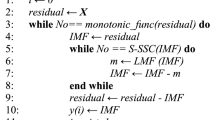Abstract
Short-term traffic flow forecasting is a key problem in the area of intelligent transportation systems (ITS). Timely and accurate traffic state prediction is also the prerequisite of realizing proactive traffic control and dynamic traffic assignment effectively. In this paper, a new hybrid model for short-term traffic flow forecasting, which is built based on multifractal characteristics of traffic flow time series, is proposed. The hybrid model decomposes traffic flow series into four different components, namely a periodic part, a trend part, a stationary part and a volatility part, to unearth the traffic features hidden behind the data. Four parts are treated and modeled separately by using different methods, such as spectral analysis, time series and statistical volatility analysis, to further explore the underlying traffic patterns and improve forecasting accuracy. Performance of the proposed hybrid model is investigated with traffic flow data from freeway I-694 EB in the Twin Cities. The experimental results indicate that the proposed model outperforms in capturing nonlinear volatility and improving forecasting accuracy than traditional forecasting methods, especially for the multi-step ahead forecasting. Compared with the ARIMA-GARCH model, it gets an improvement of 8.23% in RMSE for one-step ahead forecasting and 10.69% for ten-step ahead forecasting. It is better than the hybrid model newly proposed in literature (Zhang et al. Transp Res Part C: Emerg Technol 43(1):65–78 2014) and gets an improvement of 1.27% in forecasting accuracy.











Similar content being viewed by others
References
Wang Y, Geroliminis N, Leclercq L (2016) Recent advances in ITS, traffic flow theory, and network operations[J]. Trans Res Part C: Emerg Technol 68:507–508
Zhang Y, Zhang Y (2016) A comparative study of three multivariate short-term freeway traffic flow forecasting methods with missing data[J]. J Intell Transp Syst 20(3):205–218
Ghosh B, Basu B, Mahony MO’ (2009) Multivariate short-term traffic flow forecasting using time-series analysis[J]. IEEE Trans Intell Transp Syst 10(2):246–254
Dong C, Xiong Z, Shao C, Zhang H (2015) A spatial-temporal-based state space approach for freeway network traffic flow modelling and prediction [J]. Trans: A Transp Sci 11(7):1–14
Tang J, Liu F, Zou Y, Zhang W, Wang Y (2017) An improved fuzzy neural network for traffic speed prediction considering periodic characteristic [J]. IEEE Trans Intell Transp Syst 18(9):2340–2350
Moretti F, Pizzuti S, Panzieri S, Annunziato M (2015) Urban traffic flow forecasting through statistical and neural network bagging ensemble hybrid modeling[J]. Neurocomputing 167(C):3–7
Li Y, Jiang X, Zhu H et al (2016) Multiple measures-based chaotic time series for traffic flow prediction based on Bayesian theory [J]. Nonlinear Dyn 85(1):179–194
Pang X, Wang C, Huang G (2016) A short-term traffic flow forecasting method based on a three-layer k-nearest neighbor non-parametric regression algorithm[J]. J Transp Technol 6:200–206
Zheng Z, Su D (2014) Short-term traffic volume forecasting: a k-nearest neighbor approach enhanced by constrained linearly sewing principle component algorithm [J]. Transp Res Part C: Emerg Technol 43:143–157
Habtemichael FG, Cetin M (2016) Short-term traffic flow rate forecasting based on identifying similar traffic patterns[J]. Transp Res Part C: Emerg Technol 66:61–78
Cheng A, Jiang X, Li Y et al (2016) Multiple sources and multiple measures based traffic flow prediction using the chaos theory and support vector regression method[J]. Physica A Stat Mech Appl 466:422–434
Hu W, Yan L, Liu K, Wand H (2016) A short-term traffic flow forecasting method based on the hybrid PSO-SVR [J]. Neural Process Lett 43:155–172
Wang C, Ye Z (2015) Traffic flow forecasting based on a hybrid model [J]. J Intell Transp Syst 20(4):428–437
Wei Y, Chen M (2012) Forecasting the short-term metro passenger flow with empirical mode decomposition and neural networks [J]. Transp Res Part C: Emerg Technol 21(1):148–162
Wang J, Shi Q (2013) Short-term traffic speed forecasting hybrid model based on Chaos–Wavelet Analysis-Support Vector Machine theory [J]. Transp Res Part C: Emerg Technol 27:219–232
Chen C, Wang Y, Li L, Hu J, Zhang Z (2012) The retrieval of intra-day trend and its influence on traffic prediction[J]. Transp Res Part C: Emerg Technol 22:103–118
Zhang Y, Zhang Y, Haghani A (2014) A hybrid short-term traffic flow forecasting method based on spectral analysis and statistical volatility model [J]. Transp Res Part C: Emerg Technol 43(1):65–78
Lopez-Garcia P, Onieva E, Osaba E, Masegosa AD (2016) A hybrid method for short-term traffic congestion forecasting using genetic algorithms and cross entropy [J]. IEEE Trans Intell Transp Syst 17(2):557–569
Tan H, Wu Y, Shen B, Jin PJ, Ran B (2016) Short-term traffic prediction based on dynamic tensor completion [J]. IEEE Trans Intell Transp Syst 17(7):1–11
Blandin S, Argote J, Bayen AM, Work DB (2013) Phase transition model of non-stationary traffic flow: Definition, properties and solution method [J]. Transp Res Part B Methodol 52(2):31–55
Belletti F, Huo M, Litrico X, Bayen AM (2015) Prediction of traffic convective instability with spectral analysis of the Aw–Rascle–Zhang model [J]. Phys Lett A 379(38):2319–2330
Shang P, Lu Y, Kamae S (2008) Detecting long-range correlations of traffic time series with multifractal detrended fluctuation analysis [J]. Chaos, Solitons Fractals 36(1):82–90
Kumar SV, Vanajakshi L (2015) Short-term traffic flow prediction using seasonal ARIMA model with limited input data [J]. Eur Transp Res Rev 7(3):21
Chen C, Hu J, Meng Q, Zhang Y (2011) Short-time traffic flow prediction with ARIMA-GARCH model [J]. Intell Veh Symp 32(14):607–612
Acknowledgments
The authors are grateful to the anonymous reviewers for their comments, which will help to improve this paper.
Funding
This work was supported by National Natural Science Foundation of China [Grant No.61663021]; Scientific Research Project in Universities of Gansu [Grant No. 2015B-031]; Science and Technology Support Program of Gansu [Grant No.1304GKCA023].
Author information
Authors and Affiliations
Corresponding author
Rights and permissions
About this article
Cite this article
Zhang, H., Wang, X., Cao, J. et al. A hybrid short-term traffic flow forecasting model based on time series multifractal characteristics. Appl Intell 48, 2429–2440 (2018). https://doi.org/10.1007/s10489-017-1095-9
Published:
Issue Date:
DOI: https://doi.org/10.1007/s10489-017-1095-9




